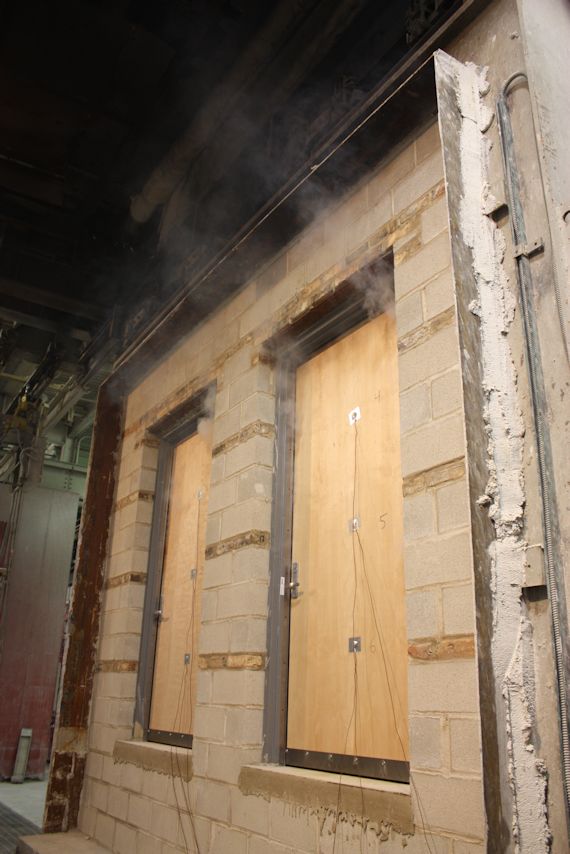
Photo courtesy of Leslie Miller, Fire Protection Publications.
The fire tests used for most swinging fire door assemblies in the US today are “positive-pressure” tests. With this type of test, the neutral pressure plane is established within the furnace at 40 inches above the floor. The neutral pressure plane separates the area of positive pressure above (which causes airflow away from the fire) from the area of neutral pressure below (which causes airflow toward the fire).
Prior to the code change mandating a positive pressure test, swinging fire doors were tested in accordance with UL 10B. During this test, the neutral pressure plane was near the top of the fire door assembly. The model codes still allow the use of the UL 10B test for some types of doors, but the positive-pressure test (UL 10C) produces conditions that are more similar to what occurs during a structure fire.
The International Building Code (IBC) allows swinging fire doors to be tested in accordance with either UL 10C or NFPA 252. NFPA 252 is a flexible test that can be used for positive-pressure testing (similar to UL 10C) or as the test that was previously common for swinging fire doors (UL 10B). Prior to the 2018 edition, the IBC mandated the location of the neutral pressure plane when using NFPA 252, in order to require positive-pressure testing:
716.5.1 Side-hinged or pivoted swinging doors. Fire door assemblies with side-hinged and pivoted swinging doors shall be tested in accordance with NFPA 252 or UL 10C. After 5 minutes into the NFPA 252 test, the neutral pressure level in the furnace shall be established at 40 inches (1016 mm) or less above the sill.
The 2018 and 2021 editions of the IBC clearly state that positive-pressure testing is required:
716.2.1.1 Side-hinged or pivoted swinging doors. Fire door assemblies with side-hinged and pivoted swinging doors shall be tested in accordance with NFPA 252 or UL 10C. For tests conducted in accordance with NFPA 252, the fire test shall be conducted using the positive pressure method specified in the standard.
Note: Fire door assemblies tested to UL 10C or NFPA 252 are fire-protection-rated. Assemblies that are fire-resistance-rated are tested to UL 263 or ASTM E119, and are addressed in ShortCodes class 3Q.
~~~
This article includes some great photos of a fire test for products used to address excessive clearances on fire doors.
The Steel Door Institute has produced a video showing a fire door assembly test:
After reviewing the article and video, proceed to the review questions below.
~~~
Review Questions
1. Which of the following tests is required by the IBC for swinging doors with a fire-protection rating?
- NFPA 80
- UL 10C
- UL 10B
- ASTM E119
2. In order to bear a fire door label, fire door assemblies must be tested by which of the following?
- The door manufacturer, in a furnace they have constructed in their facility
- A fire door assembly inspector, on-site
- An internationally-recognized independent testing laboratory
- Any of the above
3. At 30 minutes into the fire test, what is the approximate temperature within the furnace?
- 500 degrees F
- 900 degrees F
- 1200 degrees F
Answers: 1 – B, 2 – C, 3 – C
